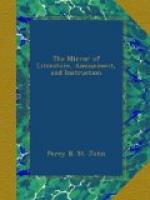* * * * *
NATURAL HISTORY.
The remarkably attractive Number of the Magazine of Natural History for the present month enables us to checker our sheet with a page or two of facts which will be interesting to every inquiring mind.
Hail at Lausanne.
“At Lausanne, on the 14th of July, 1831, about 8 P.M., we witnessed one of those hail-storms which, every summer, cause such ravages in the south of Europe. A great proportion of the hailstones were as big as hen’s eggs, and some even bigger: seven nearly filled a common dinner plate. They were mostly oval or globular; but one piece, brought to us after the storm, was flat and square, full 2 in. long, as many broad, and three quarters of an inch thick, with several projecting knobs of ice as big as large hazel nuts. This mass exactly resembled a piece of uniformly transparent ice, but the oval and globular masses had the same conformation as has often been described in these hailstones, and on which Volta founded his ingenious but untenable theory of their formation. In the centre of each was a small, white, opaque nucleus, the size of a pea, and evidently one of the hailstones usually seen in England, to which the French give the name of gresil, confining the term grele to the larger masses of ice now under our observation. This nucleus of gresil was enclosed in a coat about half an inch thick of ice considerably more transparent than it, but still somewhat opaque, as though of snow melted and then frozen again, and externally the rest of the mass was of ice perfectly transparent, and as compact and hard as possible, resounding like a pebble, and not breaking when thrown on the floor. The inhabitants of Lausanne, aware that the cinereous and puffed up appearance of the clouds charged with this tremendous aerial artillery portended more than a mere thunder-storm, had adopted the precaution of closing their Venetian shutters; but such windows as were deprived of this protection had almost every pane broken: and much damage was done to the tiles of all the houses, and to the gardens and vineyards; but less than might have been expected, owing to the short duration of the storm, which did not last longer than seven or eight minutes, and to the circumstance of the hailstones not being very numerous.”—(W. Spence.)
Cedar Wood.
“The cedar has been recommended, among other woods, for the purpose of constructing drawers for cabinets of insects. Let the inexperienced collector be warned that this is, perhaps, the very worst wood that can be employed for the purpose; a strong effluvia, or sometimes a resinous gum, exudes from the wood of the cedar, which is apt to settle in blotches on the wings of the specimens, especially of the more delicate Lepidoptera, and entirely discharges the colour. The Rev. Mr. Bree once had a whole collection of lepidopterous insects utterly spoiled from having been deposited in cedar drawers; and he has understood, also, that the insects in the British Museum, collected, he believes, chiefly by Dr. Leach, have been greatly injured from the same cause. Possibly, however, cedar wood, after it has been thoroughly well seasoned, may be less liable to produce these injurious effects.”




